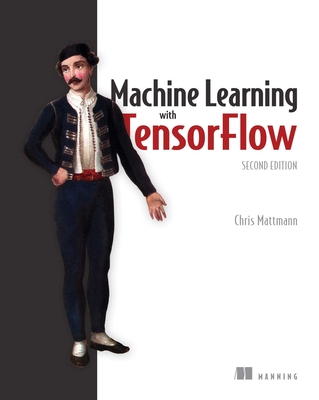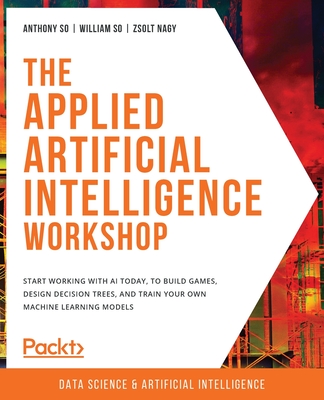Keras 2.x Projects: 9 projects demonstrating faster experimentation of neural network and deep learning applications using Keras
暫譯: Keras 2.x 專案:9 個專案展示使用 Keras 進行神經網路和深度學習應用的快速實驗
Giuseppe Ciaburro
- 出版商: Packt Publishing
- 出版日期: 2018-12-31
- 售價: $1,530
- 貴賓價: 9.5 折 $1,454
- 語言: 英文
- 頁數: 394
- 裝訂: Paperback
- ISBN: 1789536642
- ISBN-13: 9781789536645
-
相關分類:
DeepLearning
立即出貨 (庫存=1)
買這商品的人也買了...
-
 Docker 錦囊妙計 (Docker Cookbook)
Docker 錦囊妙計 (Docker Cookbook)$680$537 -
 $352Cloud Native Go : 構建基於 Go 和 React 的雲原生 Web 應用與微服務
$352Cloud Native Go : 構建基於 Go 和 React 的雲原生 Web 應用與微服務 -
 $449基於 Python 的 Google App Engine 編程 (Programming Google App Engine with Python: Build and Run Scalable Python Apps on Google's Infrastructure)
$449基於 Python 的 Google App Engine 編程 (Programming Google App Engine with Python: Build and Run Scalable Python Apps on Google's Infrastructure) -
 AI 及機器學習的經脈:演算法新解
AI 及機器學習的經脈:演算法新解$690$587 -
 $280機器學習vs復雜系統
$280機器學習vs復雜系統 -
 $301自製 AI 圖像搜索引擎
$301自製 AI 圖像搜索引擎 -
 Docker 工作現場實戰寶典 (Docker Cookbook, 2/e)
Docker 工作現場實戰寶典 (Docker Cookbook, 2/e)$520$411 -
 $709微服務架構設計模式 (Microservices Patterns: With examples in Java)
$709微服務架構設計模式 (Microservices Patterns: With examples in Java) -
 $469窄帶物聯網NB-IoT應用開發共性技術
$469窄帶物聯網NB-IoT應用開發共性技術 -
 $301特徵工程入門與實踐 (Feature Engineering Made Easy)
$301特徵工程入門與實踐 (Feature Engineering Made Easy) -
 $327Python數據科學與機器學習 從入門到實踐
$327Python數據科學與機器學習 從入門到實踐 -
 $305Python Docker 實戰 (Practical Docker with Python: Build, Release and Distribute your Python App with Docker)
$305Python Docker 實戰 (Practical Docker with Python: Build, Release and Distribute your Python App with Docker) -
 $454Go 語言高級編程
$454Go 語言高級編程 -
 $505邊緣計算方法與工程實踐
$505邊緣計算方法與工程實踐 -
 $352超聲醫學圖像去噪方法及應用
$352超聲醫學圖像去噪方法及應用 -
 $403了不起的 JavaScript 工程師:從前端到全端高級進階
$403了不起的 JavaScript 工程師:從前端到全端高級進階 -
 $564深度學習基礎與實踐
$564深度學習基礎與實踐 -
 深度學習|生命科學應用 (Deep Learning for the Life Sciences)
深度學習|生命科學應用 (Deep Learning for the Life Sciences)$580$458 -
 Python 機器學習錦囊妙計 (Machine Learning with Python Cookbook)
Python 機器學習錦囊妙計 (Machine Learning with Python Cookbook)$580$458 -
 MongoDB 從入門到商業實戰
MongoDB 從入門到商業實戰$714$678 -
 圖解資料結構 -- 使用 Python, 2/e
圖解資料結構 -- 使用 Python, 2/e$500$390 -
 Python 最強入門邁向數據科學之路 — 王者歸來 (全彩印刷第二版)
Python 最強入門邁向數據科學之路 — 王者歸來 (全彩印刷第二版)$1,000$790 -
 程式設計師從零開始邁向架構師之路
程式設計師從零開始邁向架構師之路$650$514 -
 雲端深入你我身邊:新一代邊緣運算技術直達
雲端深入你我身邊:新一代邊緣運算技術直達$650$514 -
 最佳能效晶片平台 - ARM64 架構師高度之程式開發
最佳能效晶片平台 - ARM64 架構師高度之程式開發$980$774
商品描述
Demonstrate fundamentals of Deep Learning and neural network methodologies using Keras 2.x
Key Features
- Experimental projects showcasing the implementation of high-performance deep learning models with Keras.
- Use-cases across reinforcement learning, natural language processing, GANs and computer vision.
- Build strong fundamentals of Keras in the area of deep learning and artificial intelligence.
Book Description
Keras 2.x Projects explains how to leverage the power of Keras to build and train state-of-the-art deep learning models through a series of practical projects that look at a range of real-world application areas.
To begin with, you will quickly set up a deep learning environment by installing the Keras library. Through each of the projects, you will explore and learn the advanced concepts of deep learning and will learn how to compute and run your deep learning models using the advanced offerings of Keras. You will train fully-connected multilayer networks, convolutional neural networks, recurrent neural networks, autoencoders and generative adversarial networks using real-world training datasets. The projects you will undertake are all based on real-world scenarios of all complexity levels, covering topics such as language recognition, stock volatility, energy consumption prediction, faster object classification for self-driving vehicles, and more.
By the end of this book, you will be well versed with deep learning and its implementation with Keras. You will have all the knowledge you need to train your own deep learning models to solve different kinds of problems.
What you will learn
- Apply regression methods to your data and understand how the regression algorithm works
- Understand the basic concepts of classification methods and how to implement them in the Keras environment
- Import and organize data for neural network classification analysis
- Learn about the role of rectified linear units in the Keras network architecture
- Implement a recurrent neural network to classify the sentiment of sentences from movie reviews
- Set the embedding layer and the tensor sizes of a network
Who this book is for
If you are a data scientist, machine learning engineer, deep learning practitioner or an AI engineer who wants to build speedy intelligent applications with minimal lines of codes, then this book is the best fit for you. Sound knowledge of machine learning and basic familiarity with Keras library would be useful.
Table of Contents
- Getting Started With Keras
- Modeling Real Estate Market Using Regression Analysis
- Heart Disease Classification With A Neural Network
- Concrete Quality Prediction Using Deep Neural Network
- Fashion Articles Recognition By A Convolutional Neural Network
- Movie Reviews Sentiment Analysis Using Recurrent Neural Network
- Stock Volatility Forecasting Using Long Short-Term Memory
- Reconstruction Of Handwritten Digit Images Using Autoencoder
- Robot control system using Deep Reinforcement Learning
- Reuters newswire topics classifier in Keras
- What is next?
商品描述(中文翻譯)
**展示使用 Keras 2.x 的深度學習和神經網絡方法的基本原理**
#### 主要特點
- 實驗性專案展示如何使用 Keras 實現高性能的深度學習模型。
- 涉及強化學習、自然語言處理、生成對抗網絡 (GANs) 和計算機視覺的應用案例。
- 在深度學習和人工智慧領域建立 Keras 的堅實基礎。
#### 書籍描述
《Keras 2.x 專案》解釋了如何利用 Keras 的力量通過一系列實用專案來構建和訓練最先進的深度學習模型,這些專案涵蓋了多個現實世界的應用領域。
首先,您將通過安裝 Keras 庫快速設置深度學習環境。在每個專案中,您將探索並學習深度學習的高級概念,並學會如何使用 Keras 的高級功能來計算和運行您的深度學習模型。您將使用現實世界的訓練數據集訓練全連接的多層網絡、卷積神經網絡、遞歸神經網絡、自編碼器和生成對抗網絡。您將進行的專案均基於各種複雜程度的現實場景,涵蓋語言識別、股票波動性、能源消耗預測、自駕車的快速物體分類等主題。
在本書結束時,您將熟悉深度學習及其在 Keras 中的實現。您將擁有訓練自己的深度學習模型以解決各種問題所需的所有知識。
#### 您將學到的內容
- 將回歸方法應用於您的數據,並理解回歸算法的工作原理。
- 理解分類方法的基本概念以及如何在 Keras 環境中實現它們。
- 導入和組織數據以進行神經網絡分類分析。
- 了解修正線性單元在 Keras 網絡架構中的作用。
- 實現遞歸神經網絡以分類電影評論的情感。
- 設置嵌入層和網絡的張量大小。
#### 本書適合誰
如果您是數據科學家、機器學習工程師、深度學習實踐者或希望以最少的代碼行數構建快速智能應用的 AI 工程師,那麼這本書非常適合您。對機器學習有良好的知識基礎以及對 Keras 庫的基本熟悉將會很有幫助。
#### 目錄
1. 開始使用 Keras
2. 使用回歸分析建模房地產市場
3. 使用神經網絡進行心臟病分類
4. 使用深度神經網絡進行混凝土質量預測
5. 通過卷積神經網絡進行時尚文章識別
6. 使用遞歸神經網絡進行電影評論情感分析
7. 使用長短期記憶進行股票波動性預測
8. 使用自編碼器重建手寫數字圖像
9. 使用深度強化學習的機器人控制系統
10. 在 Keras 中的路透社新聞主題分類器
11. 接下來是什麼?










